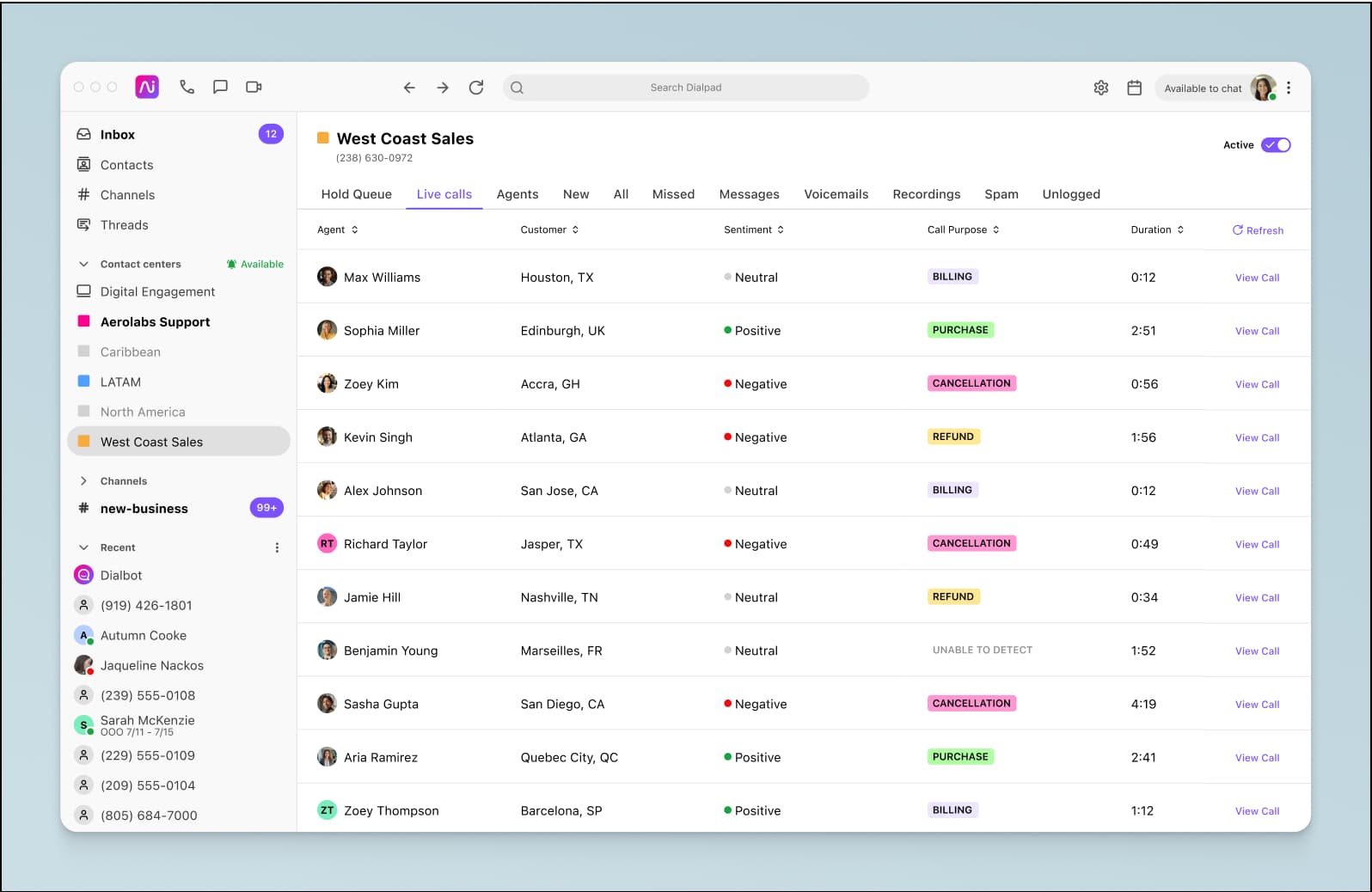Contact center automation: Your key guide to improving performance and customer service

Customer Success Engineer

Tags
Share
While contact centers are an essential part of the customer experience strategy for businesses, their operations can also be incredibly inefficient.
Agent turnover is high compared to many industries, there are a lot of manual tasks involved, and of course, customer interactions often involve a lot of back and forth.
So, how can businesses help their customer-facing teams be more productive, without investing a fortune into new systems and processes? This is where contact center automation comes in.
Keep reading to learn about what contact center automation is, how businesses are already using it to improve their operations, and what to consider when choosing automation software.
What is call center automation?
Call center automation refers to the use of technology, such as AI, to handle repetitive and time-consuming tasks in a contact center. This includes agent tasks like call routing and data entry, and also management and coaching tasks, such as QA and performance reviews.
In terms of automation tools, these can range from interactive voice response (IVR) systems to contact center AI tools like chatbots, all of which are designed to streamline operations and improve a contact center’s overall efficiency.
What are the benefits of contact center automation?
Contact center automation offers quite a few advantages for businesses. Here are a few of them.
Improved efficiency
The most cited benefit is probably the fact that automation reduces the time agents need to spend on things like entering notes from a customer call, which allows them to focus on more complex and high-impact tasks.
Ultimately, this increased call center productivity leads to faster response times and happier customers—and also greater efficiency for sales reps, who have their own automations (such as power dialers).
Improved customer experience
Speaking of which, automated systems not only help agents get to customers more quickly, they can also provide quicker responses via self-service options like chatbots. AI chatbots can handle questions directly from customers around the clock, which provides coverage for when human agents aren’t available, and ensures that your customers can get the information they need, no matter what time zone they’re in.
Cost savings
AI automations like agent assists can also help businesses reduce ramp times and training needed to onboard new agents, which significantly saves on both time and money. Gartner predicts that conversational AI will reduce contact center labor costs by $80 billion by 2026.
Along with this, There are secondary benefits like being able to manage peak call volumes without needing to hire extra staff and also making sure customers get what they need the first time they reach out—which accelerates resolution times and lets agents move on to helping the next customer more quickly.
More accurate data collection
Because automation tools can capture and analyze customer interactions, your agents don’t have to worry about manually taking notes, which reduces human error (like omitting important details or making mistakes when typing up what happened in the conversation).
Scalability
Finally, automation in call centers and contact centers are crucial to scaling up and handling increased call volumes or additional channels like social media, which makes it easier to grow the business and expand globally, without compromising service quality.
8 contact center automation trends and examples
Even though no one can predict where AI will take automated contact centers, it’s clear that it’s already dramatically changing things. Here are some key trends and advancements to be aware of.
1. Omnichannel integration
The benefits of a unified customer experience that automatically integrates multiple communication channels (like voice, email, web chat, and social media) into a single platform instead of making customers and agents pull information from many scattered conversations have been talked about for years.
Not only is it more cost-effective for companies to manage multiple communication and support channels from a single platform, it also impacts other areas. For example, companies that use omnichannel strategies retain, on average, 89% of customers, compared to just 33% for companies that don’t have omnichannel strategies.
2. Personalization at scale
For contact centers that have to handle hundreds or thousands of inquiries every day, personalization is an especially difficult task because of the sheer volume of customers that agents have to deal with.
But personalization has huge benefits. It gives you more insights about customers’ preferences and opportunities to provide tailored recommendations. And just as importantly—your customers are demanding it. According to McKinsey, 71% of consumers expect companies to deliver personalized interactions.
3. Enhanced self-service options
Businesses are also continuing to experiment with self-service options for customers. Younger generations like Gen Z and Gen Alpha are comparatively comfortable with self-service for both support and sales, and this is an opportunity for businesses to deploy more sophisticated conversational AI bots that can handle a wider range of queries.
4. Human-AI collaboration
Another trend that is only beginning to pick up steam is companies’ interest in augmented agents and enhancing their human agents' capabilities with AI tools. According to Deloitte, the vast majority of contact center leaders—81%—are already investing in AI for agent-enabling technology.
From providing real-time suggestions to speeding up information retrieval, there are so many use cases for AI from a training and skills improvement perspective.
5. Real-time analytics and reporting
Reporting is a key area where automation can lend a hand—many contact center teams and leaders spend hours every week pulling reports and spreadsheets, going through agents’ calls and conversation threads, and looking for trends and coaching opportunities.
Automation with the help of AI can significantly accelerate this process and provide actionable insights in minutes instead of hours.
Dialpad’s Ai Scorecards, for example, can analyze agents’ calls in real time and suggest whether they followed the playbooks set out for them by coaches—and instead of coaches having to listen to every call recording from beginning to end, they can quickly see at a glance Dialpad’s Ai recommendations and verify them against the transcript or recording if needed.
6. Improved compliance adherence
On a related note, an underrated benefit of automated contact centers is they tend to have agents that are good at maintaining compliance with industry or legal requirements.
For example, Medicare regulations require that all sales calls are recorded and agents have to mention a standardized disclaimer about the availability of services at the beginning of each call.
Automations such as AI coaching can nudge agents if they forget and make sure that they remember to execute these tasks during customer conversations, with minimal manager oversight required.
7. Emotion detection and sentiment analysis
Sentiment analysis is a particularly useful contact center automation tool because it can detect and analyze customer emotions during conversations in real time—and by extension, which agents may need managers’ help to save a call and turn things around.
Instead of an agent having to switch to a different messaging app and sending their manager a note to join the call, a sentiment analysis feature like the one in Dialpad’s conversation intelligence platform automatically flags calls with negative sentiment to get coaches’ and managers’ attention:

8. Advanced AI and machine learning
Finally, machine learning will only continue to make AI-powered call center automation solutions more accurate over time.
Already, AI can predict customer behavior and needs, enabling more proactive service and impactful marketing campaigns. Forrester even cites fraud identification and mitigation as a key benefit of predictive AI, which will be helpful for contact centers such as insurance and healthcare.
What to look for in call center automation software
If you’re looking for call center automation software, here are some important factors to consider:
1. Ease of integration
The solution should seamlessly integrate with your existing tech stack including your CRM and other communication tools. This will help streamline operations and costs, and also make life easier for your agents and customers.
2. Scalability
Look for software that can scale as your business grows. If your contact center is going to expand to other regions in the future, having automations in place will help your agents and coaches handle those higher conversation volumes.
3. Customizability
Choose a solution that is easy to customize, so you can tailor the automation features to your specific business requirements. (For example, customizable IVR menus, chatbot scripts, and reporting dashboards.)
4. User-friendly interface
The software should be easy to use—an intuitive, well-designed interface will minimize the learning curve and help your team get onboarded quickly.
5. Analytics and reporting
A good contact center automation tool should have robust conversational and voice analytics, and reporting features. These will help you track performance metrics, identify trends, and make more data-driven decisions to improve your operations.
6. Support and training
Something that many companies forget to check is the level of support their software provider offers—make sure you have access to comprehensive support (ideally over the phone, not just live chat) and training resources. This will help your agents and managers get up to speed quickly and resolve any issues that might pop up.
Challenges and considerations of contact center automation
To automate call center operations, it’s best to have a solid plan of attack because there are several challenges that will undoubtedly come up in the process.
Assessment and planning
First, do a thorough assessment of your current contact center processes. This includes mapping out existing workflows, and identifying any repetitive tasks and pain points in customer interactions.
Initial costs
Implementing a contact center automation solution involves an initial investment that will vary depending on the complexity and scale of your solution.
Purchasing a subscription to automation software is a core part of the expense. Most solutions may offer tiered pricing based on features or usage levels. It’s important to weigh these initial costs against the long-term benefits of automation, such as reduced operational expenses and improved efficiency. There are some automated call center solutions that look very inexpensive upfront, but the inefficiencies and hidden add-on costs ultimately cost more than other tools, so pay attention to the fine print in pricing plans.
Training and support, change management
To successfully implement any new technology, you need effective training and change management. Your agents need to be equipped with the skills to use new tools, especially if they involve new workflows too.
You might want to develop training programs that cover the functionality of new tools, best practices, and troubleshooting, and have a plan to address resistance to switching to a new platform.
Involve your staff in the transition process and when in doubt, over-communicate. Regular updates, feedback sessions, and incentives can go a long way in easing the adjustment period.
Maintaining the personal touch
From a customer perspective, while automation improves efficiency, it’s also important not to overdo it. There are few things more aggravating to a customer than not being able to reach a person when they have an especially complicated issue or request.
To balance automation with personalized service, make sure your automation tools complement rather than replace human interaction. For example, if you have a conversational AI bot on your website, there should be an escalation option to talk to an agent (that is easy to access).
Elevate your CX with contact center automation
Forward-looking businesses are already using contact center automation to transform the way their teams manage customer interactions, and make significant improvements in efficiency, customer satisfaction, and cost savings.
If you want to learn how to implement contact center automation in your business, book a product tour of Dialpad Support to see how it works!
Want to see how Dialpad Support can work for your team of supervisors and agents?
Book a product demo to learn about how you can use RTA cards, Custom Moments, and more. Or, take a self-guided interactive tour of the app!








